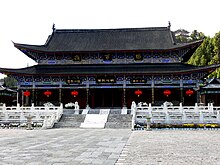| Tusi | |||||||||
|---|---|---|---|---|---|---|---|---|---|
 Chiefdom of Lijiang's Palace Chamber | |||||||||
| Chinese name | |||||||||
| Chinese | 土司 | ||||||||
| Hanyu Pinyin | Tǔsī | ||||||||
| |||||||||
| Tibetan name | |||||||||
| Tibetan | ཐོའུ་སི | ||||||||
| |||||||||
| Vietnamese name | |||||||||
| Vietnamese alphabet | Thổ ty | ||||||||
| Chữ Hán | 土司 | ||||||||
| Manchu name | |||||||||
| Manchu script | ᠠᡳᠮᠠᠨ ᡳ ᡥᠠᡶᠠᠨ | ||||||||
| Möllendorff | aiman i hafan | ||||||||
Tusi, often translated as "headmen" or "chieftains", were hereditary tribal leaders recognized as imperial officials by the Yuan, Ming, and Qing dynasties of China, and the Later Lê and Nguyễn dynasties of Vietnam. They ruled certain ethnic minorities in central China, western China, southwestern China, and the Indochinese peninsula nominally on behalf of the central government. As succession to the Tusi position was hereditary, these regimes effectively formed numerous autonomous petty dynasties under the suzerainty of the central court. This arrangement is known as the Tusi System or the Native Chieftain System (Chinese: 土司制度; pinyin: Tǔsī Zhìdù). It should not be confused with the Chinese tributary system or the Jimi system.
Tusi regimes were located primarily in Yunnan, Guizhou, Tibet, Sichuan, Chongqing, the Xiangxi Prefecture of Hunan, and the Enshi Prefecture of Hubei. Tusi entities were also established in the historical dependencies and frontier regions of China in what is today northern Myanmar,[1] Laos,[2] and northern Thailand.[3] The Vietnamese Later Lê and Nguyễn dynasties also implemented the Tusi system.[4]
In 2015, UNESCO designated three Tusi castles (Laosicheng, Tangya, and Hailongtun) as part of the "Tusi Sites" World Heritage Site in China, owing to the unique system of governance.[5] It has been described on at least one occasion as sharing similarities with the "U.S. federal government's recognition of some Native American tribes as in some ways sovereign entities."[6]
- ^ 缅甸土司制度的兴衰(1287—1959年): cnki.com.cn
- ^ Ming Veritable Records - 《明实录》 or History of Ming 《明史·老挝传》
- ^ 傣族的土司制度与傣族文化: mzb.com.cn or cnki.com.cn
- ^ Journal of Guangxi Teachers Education University (Philosophy and Social Sciences Edition) Vol.37 No.1 (Jan. 2016) - 《越南阮朝土司制度探析》, see docin.com
- ^ "Tusi Sites". UNESCO World Heritage Centre. United Nations Educationa;, Scientific, and Cultural Organization.
{{cite web}}: Missing or empty|url=(help) - ^ Dardess 2012, p. 3.